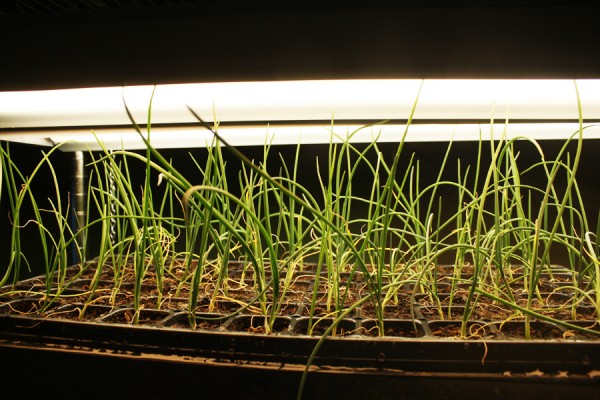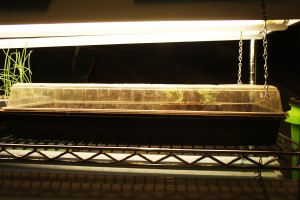A Guide to Starting Seeds and Planting in Alaska
Lighting and Temperature
Lighting:
Obviously, most plants love light. With this in mind you want to make sure that:
- You have strong enough light
- You have the right amount of daylight hours
You don’t have to spend a fortune on special grow lights. For my seed starting, I use a rack I bought at Costco ($120) and 2 fluorescent light fixtures from Walmart ($12 each). I have my lights hooked up to an automatic outlet timer and I give them about 18 hours of light a day. The most important aspect is the intensity of the light. If the lights are place too far away from the seedlings, they will grow leggy and weak is search for light. Too close to hot lights, and they’ll fry. I find that my fluorescent lights work just fine. I have the lights on adjustable chains and I make sure to put them as close to the seedlings as I can. They’re not hot enough to burn the seedlings, but that way, the baby veggies get the most possible light. I then move the lights as the plants continue to grow.
** By April 1st, there is enough daylight in AK to start seeds near a window without supplemental light. However, if you have supplemental lights, you should use them. It will increase plant strength and prevent the seedlings from getting too leggy.**
Temperature:
Temperature is a little more tricky. Plants like tomatoes, corn, squash, cucumbers, and melons all thrive in warm climates. On the other hand, cabbage and broccoli love cool weather and don’t do well when temperatures are too warm. I solve this by planting all of my seeds in a tray with a clear plastic cover. This actually traps a lot of heat from the lights, and also keeps the soil from drying out. Once the seedlings have sprouted, I take the cover off for cool-weather crops like cabbage. I leave it on for warm weather plants until the seedlings outgrow the clear cover.
Another consideration is to start your warm weather plants a week or two early. That way, you can keep the temperature down (below 70F). The warm weather plants may grow slower, but you’ve given them a couple of extra weeks to make it up.
Other Considerations:
One of my first years of gardening, I planted cabbage and tomatoes alongside each other and cranked the temperature up without enough light. My cabbage and broccoli grew extremely leggy and eventually died, while my tomatoes thrived. Members of the cabbage [brassica] family (cabbage, brocolli, kale, brussel sprouts) love to grow leggy and weak when they sprout. To help them remain healthy and stocky, I do four things:
- I make sure the temperature is not too high
- I make sure the lights are as close to possible.
- I run a small oscillating fan next to the seedlings. This makes the seedlings create stockier, stronger stems.
- Whenever I walk by, I roughly run my hand over the top of the seedlings, as though I were rustling someone’s hair.
Caring for Your Baby Veggies
Once your seeds sprout, they simply need to be regularly watered and exposed to 14-18 hours of daylight. Keep the soil moist but not water-logged. Check the weight of your seedling pots. It should feel like it has some moisture in it, but not heavy. Additionally, some plants, like basil or peppers, should be pinched at the top of the plant when they have 4-8 true leaves. This will encourage them to grow side shoots and form a bushier, more productive plant.
Getting Your Plants Ready for the Garden:
In mid-May, about two weeks before you plan to put your veggies in the garden, it’s time to “harden them off.” Your plant babies have had it easy indoors with artificial light and little wind. It’s time to toughen them up. Gardeners will argue about whether hardening off is really about getting the plants used to the cold, the wind, or the sunlight. I happen to believe that it is all the above.
Start by putting your plants outside for about an hour a day. Place them in partial shade. If plants are too quickly exposed to direct sun, their leaves can actually get sunburned and the plants can die. Every few days, increase your plants’ time outdoors by an hour or two. At the end of two weeks, just before your plants are placed in the garden, they should be spending 24 hours outside. Water sparingly during this period of “hardening off.”
Click below for the next page!




I’m so excited to have happened across this blog! I’ll be exploring it over the next few days, and am looking forward to Spring!
Hi, Where can I find Fishy Peat Potting Soil? Thanks!
I know it’s for sale at Dimond Greenhouse, 3 Bears, and Alaska Mill and Feed.